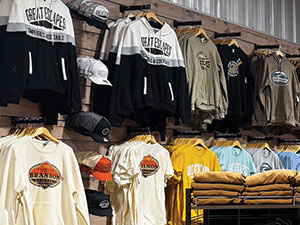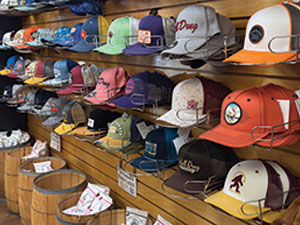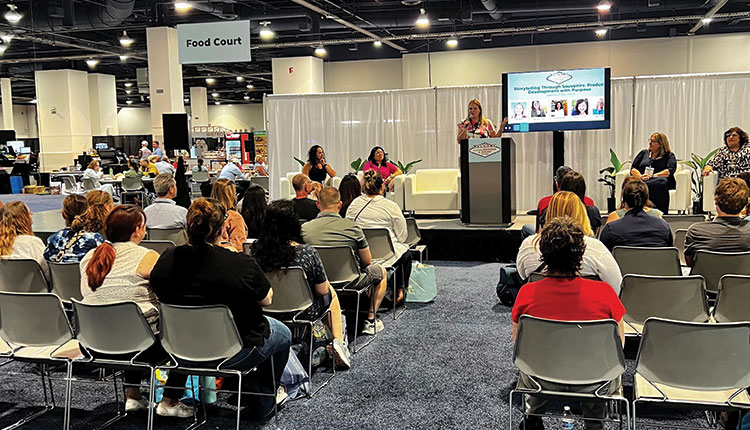Las Vegas Souvenir & Resort Gift Show panelists explore how retailers and vendors create meaningful souvenirs.
Souvenirs are more than just “stuff” on a shelf — when done right, they become vessels of memory, storytelling and connection. That was the theme of the panel “Storytelling Through Souvenirs: Product Development with Purpose,” held during the Las Vegas Souvenir & Resort Gift Show in mid-September.
Moderated by Kristin Ely, executive editor, Souvenirs, Gifts & Novelties magazine, the discussion brought together a diverse panel: Angela Dalby, vice president of marketing, sales and creative, Charles Products Inc.; Kelly Jones, vice president of operations, Great Escapes RV Resorts; Jackie Kusser, executive buyer and receiving supervisor, Wall Drug; and Melissa Lew, jewelry artist/owner, Melissa Lew.
Vessels of memoryWhen asked how souvenirs go beyond being “stuff” to become carriers of memory and story, panelists emphasized emotional connections and functionality.
 Great Escapes RV Resorts’ apparel items capture the spirit of each of its locations. “Souvenirs … often can remind people of one of the favorite things they did with friends or a family member,” said Dalby. “They also have the ability to have your brand go home, especially if it’s functional. They’re reminded of your location, that memory and that family connection.”
Jones noted how souvenirs can extend an experience. “We did a color-your-own bandana for dogs. It wasn’t just a bandana; it was an activity and a memory.”
For Lew, accuracy and authenticity play a role in memory-making. “As an artist, that’s one of the biggest reasons why I do so much research,” she said. “I want to make sure that whatever I create really does reflect history or culture, because those are important memories for people. It connects them to the attraction.”
Kusser pointed to Wall Drug’s famed five-cent coffee as an example of how something simple can span generations. “That cup of coffee connects generations together,” she said. “And you can buy a Christmas card in the shape of the cup. It becomes its own story.”
Retail goals and storytellingThe conversation then turned to how retailers balance retail goals with authentic storytelling.
Dalby stressed alignment among product, brand and values. “You want to make sure all that aligns,” she said. “It sounds silly, but all of that is so important to make sure it’s not disappointing.” She added that products themselves can become vehicles for storytelling, whether the story is eco-friendly values or a historical narrative.
Jones described how she uses built-in characters from the Yogi Bear–themed Jellystone Park resorts to guide product design. “Yogi is mischievous, Boo Boo is the conscience, Cindy Bear is the southern belle,”
she explained. “I would never put Boo Boo in a situation where he’s being mischievous. I try and build my line like a complete sentence, so I have a whole story I can tell.”
Lew emphasized communication with buyers and vendors. “You know your story best,” she said. “Don’t be afraid to tell vendors what won’t work and why. When you work together as partners, everybody succeeds.”
For Kusser, fair pricing is part of the storytelling. “I keep prices fair so guests not only hear the story but feel good about their purchase,” she said. “That’s marketing — when they leave and feel good about the experience.”
Customization: Who should do it?When the panel was asked who should pursue custom products, the consensus was clear: everyone.
“Don’t let customization scare you,” said Jones. “You can take a template a vendor already has and tweak it to your property. It doesn’t have to be built from the ground up.”
Kusser agreed. “Everyone should do something custom,” she said. “If you make yourself just a little bit different, you’re not going to look like the same shop. That’s important to customers.”
Dalby, who used to be a retail buyer, cautioned that customization should always be thoughtful. She recalled inheriting a container of custom ashtrays — for a non-smoking property. “You can make anything custom, but make sure it’s what your customer wants,” she said.
Lew encouraged retailers to explore collaborations with local makers, “especially emerging artists — those cool, special pieces can really resonate with your customer.”
Jones also noted that not everything in a store has to be branded sharing what she learned about Dollywood at a recent conference. “Only about 30% of souvenirs actually have ‘Dollywood’ on them,” she asserted. “Custom is great, but you also need regional or complementary items.”
Lessons learnedIn closing, panelists reflected on lessons they wished they had known earlier in their careers.
“My biggest mistakes were buying for myself, not my customers,” Dalby said. “I declined a shirt I didn’t like — and everyone else loved it. That taught me to listen to the customer.”
 Wall Drug’s wall of caps caters to an array of customers who stop in for a bit of nostalgia on their way to Mount Rushmore or Rapid City. Jones relies on her family and staff to test ideas. “I’ll send designs to my 27-year-old daughter and ask, ‘Would your friends buy this?’ She is my harshest critic, but she’s usually right,” Jones said.
Kusser emphasized the value of listening to vendors. “Good vendors will steer you in the right direction,” she said. “They’re seeing demand across markets, and they’ll tell you what works.”
Lew added that retailers should not be afraid of experimentation. “If at least 10% of your products don’t fail, you’re not taking enough risks,” she said, referencing advice she had heard earlier at the show.
|




